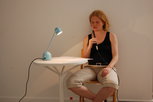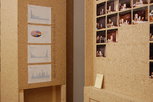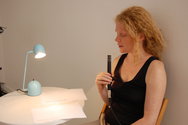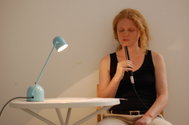Comparison of artefacts of a spoken-word performance by Gisela Hochuli (artist, Bern) on 19th August 2011 during the exhibition and mediation project archiv performativ: a model in the Klingental exhibition space, Basel
A) Synopsis of the spoken-word sound poetry performance “Analyse der Biografien aus den Archivschachteln” [Analysis of biographies from archive boxes]
The spoken-word performance Analyse der Biografien aus den Archivschachteln by Gisela Hochuli was given in the first week of the model archive, using data from the curricula vitae of other artists which Hochuli found in the archive’s files. Hochuli processed the data by asking the following questions: “Birth years: How many artists were born in each year?”, “Countries: How often does each appear in the biographies?”, “Cities: How often do they appear in the biographies?” and “Schools?” She then used this material to draw up statistics which she illustrated in diagrams on A3-format sheets. On the night of the performance, these sheets were pinned to the inside of the cupboard doors which led from the exhibition area of the model archive to the media room at the rear. The performer sat in the media room at a small round table and read the collated data into a microphone; her voice could also be heard through a loudspeaker in the exhibition area of the model archive. Gisela Hochuli began her reading before the audience had arrived and did not finish it until the next performance that evening had begun. She described her performance as “Poésie Sonore”[1], in reference to a procedure which detaches language from its framework of meaning, and read the words of the performance foregrounding the physicality of her voice. To collate the data, Hochuli used scientific research methods which she expressly intended to apply ad absurdum; for example, by generating data which did not seem to contain any relevance. Her work can be interpreted as an experimental transmission proposal, or as a trial transmission, with which the performer transformed the selected material into an acoustic experience by sound-poetic means.[2]
B) Selection of artefact types
I analysed the transmission function of the selected artefacts – the soundtrack of the handheld camera (length 5.54 minutes), the photographs (eleven images) and the column and pie diagrams produced by the artist, here classified as artefact type ‘object/material (relic)’ – and considered them in comparison to each other. In order to focus on the specific medial functions of these artefacts, I deliberately disregarded the images conveyed by the video recording.
C) Similarities/differences in transmission and transcription of the performance by the artefacts in view of the different constituent aspects of the performance
Eight photographs show Gisela Hochuli sitting next to a round table on which a light blue, illuminated table lamp is placed. She is holding a microphone in her hand. On some photographs we see her talking into the microphone. On two pictures the inside of the cupboard doors can be seen, which were designed to form an entrance to the ‘media room’ in the exhibition of the model archive. On the doors we see four sheets of diagrams, titled “Jahrgänge” (‘birth years’), “Länder” (‘countries’), “Städte” (‘cities’) and “Schulen” (‘schools’). On another photo, we see the loudspeaker on a shelf via which the reading was broadcast from the media room to the exhibition room. No audience can be seen on the pictures, suggesting that the photographer confined herself to portraying the artist, the material and the medial realisation of the performance. The photographs convey an impression of the setting and the diagrams shown point to the content of the performance and what could be heard through the loudspeaker.
The soundtrack, in comparison, reconstructs some of what was heard at the sound poetry reading. At the beginning, we hear visitors’ voices as they greet each other and chat. After about 30 seconds, the performer’s voice sounds out and proceeds to read out the names of national and international colleges, enunciating clearly, calmly, rhythmically and monotonously. The reading remains acoustically in the foreground while the voices of the visitors and, now and again, steps can be discerned in the background. At the end of the recording, only the voices of the audience can be heard. The volume of the spoken-word performance fluctuates, growing louder or softer according to the distance of the microphone on the video camera from the artist or the loudspeaker. The soundtrack, then, conveys the live situation acoustically – both the performer’s voice and the voices of the visitors.
In the given setting, Hochuli’s sound-poetic spoken-word performance could only be perceived by visitors or received in its entirety if they went into the media room or if they consciously listened to the voice coming from the speaker. Since no audience is shown on the photographs, this aspect, which is discernible from the audio recording, is not represented in the visual artefacts.
On the third type of artefact, the diagrams, we read the heading “Analyse der Biografien aus den Archivschachteln” which, if taken as a source reference, allows inferences to be made about the origin of the data. During the performance, these diagrams assumed the function of scripts or notations, while also superficially representing a sociological scientific examination, the ‘findings’ of which were read out. In summary, each artefact in isolation – the soundtrack, photographs or diagrams – conveys only a fragmentary impression of the content of the performance. This spoken-word performance can, however, be reconstructed and appreciated by means of a combination of different artefacts. The circumstances of the performance are legible in the artefacts and the reference to the ‘analysis of biographies from archive boxes’ on the diagrams makes the conceptual background of the performance clear.
The soundtrack of the video recording, lasting just under six minutes, gives no indication of the effective length of the performance. And no further pointers are legible in the artefacts; even the total of eleven photographs offer no indication of the performance’s duration. The choice of site for the performance – a room lit with artificial light – makes the time of day indiscernible. While the artist’s clothing seen on the photos (light, rolled-up beige trousers, a sleeveless black t-shirt and flip-flops on bare feet) suggests warm weather, the visitors’ voices in the background of the soundtrack convey the impression of a relaxed atmosphere. The photographs show that the performance took place in the model archive in the Klingental exhibition space, marking the contextual frame of the performance.
D) Comparative analysis
Gisela Hochuli attended the first week of the model archive and devised her performance during this time. The work can be classified as a spoken-word performance since the performer’s voice is an essential element and distinguishing feature of it. Drawing her inspiration from the archived material and artefacts concerning individual artists who appeared at the Kaskadenkondensator in Basel between 1998 and 2008, Hochuli extracted the biographical data and left the remaining material aside. Her approach, applying a scientific method for formulating statistics, is remarkable for disregarding the artists’ work and concentrating on their biographies. By so doing, she transformed a position of inquiry into a spoken-word performance. This can be read as a simultaneously fragmentary and purposeful transcription of the archive. Hochuli took the data – the artists’ curricula vitae – out of its original context – the archive boxes of the model archive – and de-personalised it. With her choice of site and title (“Analyse der Biografien aus den Archivschachteln” or ‘Analysis of biographies from archive boxes’) for the performance, she re-established a link with the original context. No acoustic, technological distortions or manipulation were used in the performance; Hochuli spoke into the microphone with a clear, constantly pitched voice. By means of the language embodied by the performer, or language made physical, without any discernible purpose, a performance was created which could nevertheless be expressly linked with the documentary elements of the model archive and even disclosed the source of the data itself.
In terms of history, after Michel de Certeau, this spoken-word performance can be seen as an archiving procedure: “In history everything begins with the gesture of putting aside, of combining, the transformation of certain, differently classified objects into ‘documents’. In reality it consists of producing such documents by copying, transcribing or photographing these objects, since it simultaneously changes their site and their status.”[3] The source material used by the artist was transposed to an artistic context by means of a scientific, quantitative procedure, giving rise to independent artefacts (diagrams). The work connotes the gesture of ‘putting aside’. Michel de Certeau emphasises that the problem consists not only of bringing these documentary fields to life, which was realised here in experimental terms by processing the material on the Kaskadenkondensator in the model archive, but also that “lending a voice to silence or validity to a possibility […] also means transforming something that had a certain status and a certain role into something else which functions differently.”[4] The aim of the model archive was to revive the documentation material from the Kaskadenkondensator. Gisela Hochuli’s work can be read as an adequate transcription and her sound-poetic spoken-word performance was an experiment that fulfilled precisely this demand.
In my view, the photographs of the performance do not have any iconographic value since they do not allow any inferences to be made about the content of the performance. They are pictures which function according to the ‘witness’ principle (Gernot Böhme: “Zeug/innenschaft”) since they show what could be seen from the same perspective by eyewitnesses in the same place. “The selection criterion for photography – that nothing is shown which was not visible from a certain position – is trivially fulfilled, recommending it as especially realistic.”[5] This is the case where the eleven photographs considered here are concerned, although they portray the event that took place despite the partial and subjective view which is inherent to every photograph. Every photograph depicts a certain moment within a time continuum and, as an artefact, is well suited to inscribing whatever information it conveys on to the public’s cultural memory. The limited number of pictures of this performance leaves it up to the observer to imagine the event and transcription is only possible in combination with the additional artefact types ‘soundtrack’ and ‘object/material (relics)’.
Margarit von Büren, May 2012
[1] This sound-based approach has its roots in modern lyric poetry. ‘Sound poetry’ denotes an artistic form which downplays the role of meaning in language and hence the semantic and syntactic functions of language. It links literary and musical composition and places the emphasis on sound. Pioneers of the genre were involved in the DADA movement and prominent sound poets range from Kurt Schwitters to artists linked with today’s rap and slam poetry scene. Cf. http://en.wikipedia.org/wiki/Sound_poetry (last accessed 12.7.12).
[2] This description is based on my personal recollection as an eyewitness; I was present at the public event as well as at the entire first week of the model archive.
[3] Translated from the German: „In der Geschichte beginnt alles mit eine Geste des Beiseitelegens, des Zusammenfügens, der Umwandlung bestimmter, anders klassifizierter Gegenstände in ‚Dokumente’. In Wirklichkeit besteht sie darin, derartige Dokumente durch Kopieren, Transkribieren oder Photographieren dieser Gegenstände zu produzieren, da sie gleichzeitig ihren Ort und ihren Status verändert.“ De Certeau, Michel, „Der Raum des Archivs oder die Perversion der Zeit“, in: Knut Ebeling / Stefan Günzel (eds.), Archivologie. Theorien des Archivs in Philosophie, Medien und Künsten, Kadmos, Berlin 2009, p. 113.
[4] Translated from the German: „…dem Schweigen eine Stimme oder einem Möglichen Geltung zu verleihen [,…] das bedeutet auch, etwas, das einen bestimmten Status und eine bestimmte Rolle hatte, in etwas anderes, das anders funktioniert, zu verwandeln.“ De Certeau, op. cit. fn 3, p. 116
[5] Translated from the German: „Für die Fotografie ist das Ausschlusskriterium – dass nichts gezeigt werde, was von einem bestimmten Standpunkt aus nicht sichtbar war – trivialerweise erfüllt, wodurch es sich im besonderen Masse als realistisch empfiehlt.“ Böhme, Gernot, Theorie des Bildes, Fink, Munich 1999, p. 114
Audio
Files










